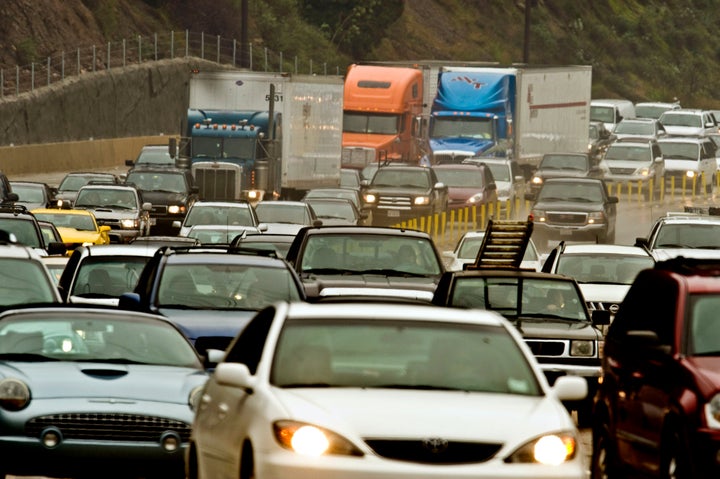
Yesterday, joined and supported by business leaders and CEOs from across Maryland, I testified before the Maryland General Assembly on the need to invest in infrastructure today to create jobs and move forward with needed maintenance and repair projects rebuilding our roads, bridges and other transit systems.
Here's the full text of my testimony:
Thank you very much for the opportunity to testify today.
As we consider the urgent question of transportation funding, let me begin with three facts about our shared reality:
Fact #1: As a State, we now have the longest average daily commute in America... Longer than New York. Longer than New Jersey. Longer than Illinois. Longer than California.
Fact #2: These ever growing congestion costs are the direct result of an ever declining revenue source -- a flat, fixed rate per gallon tax. Meanwhile, the real purchasing power of the gas tax has declined by 80 percent since 1992. And it now costs more to paint the Bay Bridge than it did to build the first span.
Fact #3: Even if we were to apply the 6 percent sales tax to a gallon of gasoline, Marylanders will be paying a smaller portion of their gas bill to taxes now than we were in 1992.
We Pay for That Too...
Progress is a choice; job creation is a choice; allowing worsening congestion to rob of us of ever greater amounts of our time and of our money and of our productivity... this too is a choice. We make our own future, we govern ourselves; and to govern is to choose.
A couple of days ago, I was talking to a businessman from Southern Maryland who was in Annapolis for Leadership Maryland, and he said to me: "Governor, let me just say: I'm against all taxes... but we pay for that, too."
Indeed we do... We pay for that too.
None of us wants to pay more at the pump. We do not have to do this. But, you here know, that if we don't... we will pay for that too. Inaction has a cost.
We don't have to widen 301... but if we do not, inaction has a cost, and we'll pay for that too.
We don't have to move forward on congestion relief at Indian Head Highway... but if we do not, we'll pay for that too.
We don't have to rebuild the Dover Bridge... but if we do not, we'll pay for that too.
We don't have to do the Corridor Cities Transit Way, the Red or Purple lines... we don't have to repair the bridges that feed the Port of Baltimore... but if we do not, inaction has a cost and we'll pay for that too.
Roads do not upgrade or maintain themselves. Bridges do not repair themselves or rebuild themselves. Minneapolis, Kentucky, Ohio are not the only places where bridges crumble as they get older. Our transportation infrastructure here in Maryland does not grow broader or stronger with age.
The Ever-Increasing Cost of Doing Nothing
No one has wanted to address this problem for twenty years, and every year, therefore, our people are paying an increasing cost for this inaction... and in so many different ways.
As the Baltimore Sun editorialized: "Higher prices at the pump may be unwanted, but a deteriorating transportation system is costly, too. Not only in mere congestion but also in lost economic opportunity."
It is the cost of time lost sitting in traffic when we should be at home with our families. It is the cost of gasoline and money lost idling in bumper to bumper beltway traffic that looks a lot more like a parking lot than it does like a highway... at rush-hour and at non-rush-hour as well. It is the cost of lost productivity at work...
... It is the ever increasing cost of damage to our air and environment. It is the cost we incur to our very quality of life... all of which effects our economic competitiveness as a people and as a State; that is, our ability to attract and retain more and better jobs for ourselves and our children.
How Much Less Would Be Good for Maryland?
As we search for common ground and a way forward, as we look for the good intentions of one another, let's ask ourselves, if doing less will address this problem?
Let's ask ourselves if getting along with less will help us avoid these ever escalating costs?
With our increased population, how many fewer highway lane miles do we need? How many fewer MARC trains? How many fewer Metro lines do we need; how many can we shut down? How many fewer jobs do we need? How many of those 106 structurally deficient bridges do we no longer need; how many of them can we shut down? How many fewer hours do we need with our families, or at work?
Everything has a cost. There is no way to construct a $100 million bridge for $10 million. There is no way to buy a 2012 model hybrid car for 1991 prices.
We cannot maintain, or build out, a 21st century transportation system for a population our size with a level of investment that was fixed 20 years ago.
Yes, we are all against taxes... but we pay for that too; and in this case, doing less will actually cost us more.
Our Proposal
Through the years, there have been many recommendations on funding options. Most have gathered more dust than support.
Our proposal would phase in -- at no more than 2 percent a year over the course of the next several years -- the current State sales tax of 6 percent.
Our proposal protects consumers with a braking mechanism should the price of gas spike beyond 15 percent in any given year.
It protects new revenues from being used for priorities other than their intended transportation purpose.
It helps our county and municipal governments by restoring some of the funding lost when State grant programs were cut in the final budgets of the recession.
It protects the health and safety of every citizen in Maryland not only through more structurally safe bridges and roads, but also with an investment in the Maryland Emergency Systems Operations Fund...
Finally, it puts 7,500 moms and dads back to work (mostly) in our hard hit construction trades -- building needed roads, and public transit throughout our State. And it paves the way for future job creation, economic growth and opportunity in Maryland that is smart, green, and growing.
Less traffic, better transit, and an upgraded infrastructure and a better quality of life make a big difference for our top priority of retaining, attracting and growing jobs in Maryland; it makes a big difference in terms of the expanded opportunities we are able to give our children
The bill you consider will create jobs and improve the conditions that allow businesses to create and save jobs; it will allow us to better protect the public's safety on highways and bridges; and, it will allow us to grow our economy, create better jobs, and expand opportunity to greater numbers of our people.
Forward or Back?
In conclusion... to create jobs, a modern economy requires modern investments; investments that we can only make together; investments by all of us for the benefit of all of us. That's not a Democratic or a Republican idea; it's an economic and historic truth. It was true for our parents, it was true for our grandparents, and it is a truth that has built our State and has built our country.
Progress is a choice.
None of us want to look back someday -- as bridges start collapsing and closing in our own State -- and tell our kids that we could have done something, but we chose not to... we chose instead to simply kick the can down the road.
Yes, we're all against taxes... but we pay for that too.
Given the shared realities we face, the cost of inaction is greater than the cost of action...
So let us move forward.
For greater jobs and greater opportunities, for a better quality of life for Maryland, the choice is ours.
